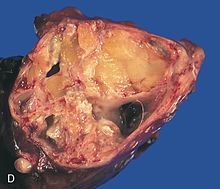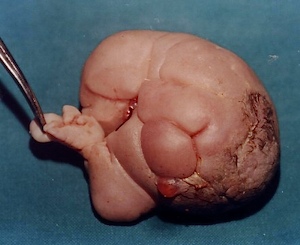Teratoma is a form of neoplasm that causes abdominal pressure and inflammation and even cancerous developments in sufferers. Read and know all about the condition, including its causes, symptoms, diagnosis, treatment and more.
Teratoma Definition
Page Contents
It is a form of germ cells tumor that is constituted of various types of cells. These are supposed to be congenital (or present at birth) although small ones are often undiscovered until much later in the life of sufferers.
Teratoma ICD10 Code
The ICD10 Code for this disorder is C62.9.
Teratoma Etymology
The term “Teratoma” is Greek in origin and literally stands for “monstrous tumor.”
Teratoma Causes
This type of tumor arises when the germ cells begin to replicate in an abnormal way, contrary to their nature. A teratoma arises when a pocket of germ cells begin multiplying and various different forms of tissue start to develop although the tissue is not generally functional.
Historically, these growths had been of immense interest for medical researchers and practitioners. Teratoma tumors of particularly large size or abnormally complex nature were preserved as specimens. Medical practitioners were excited at the opportunity to operate on these types of growths.
Types of Teratoma
Teratoma can be classified into the following types:
Sacroccygeal Teratoma
Sacroccygeal Teratoma (SCT) is a type of Teratoma that arises at the base of the tailbone or coccyx. It is found to arise in one out of every 35,000 newborns. It is the most common type of tumor in newborns and is generally non-malignant at the time of birth. The term “Sacroccygeal” indicates an area of the body – the sacral area (the lower back) and the coccygeal region (the tailbone area).
Sacroccygeal Teratoma Symptoms
This form of growth is most commonly observed in young children and infants. It represents a development of a number of varied forms of cells. It is commonly detected after spotting a bump or lump in the lower back area.
These tumors can give rise to various signs and symptoms. The most common of these symptoms include protrusion of a lump from the sacroccygeal area of the body. The internal development of the tumor can give rise to various other symptoms, which can result in an obstruction of the gastrointestinal tract or the urinary tract. The blockage of the urinary tract can result in bowel obstruction, which may give rise to problems like:
- Vomiting
- Pain
- Abdominal distension
- Constipation
Sacroccygeal Teratoma Diagnosis
The neoplasm can be detected by various means, mainly imaging tests of different types. SCTs can be often diagnosed by a method known as Prenatal ultrasound. In such patients, the diagnosis is confirmed after birth by CT (Computed Tomography), MRI (Magnetic Resonance Imaging) and other imaging studies. Young children and infants can be diagnosed with these neoplasms. Sufferers of these tumors are detected on the basis of the symptoms. The diagnosis of these growths is confirmed with a MRI or CT scan.
Sacroccygeal Teratoma Treatment
Surgery is the first step in the medical cure of this growth. Operative removal is important as the tumor can turn malignant in nature. The method used to conduct the operation depends on the size of the SCT. The growths can often be very large in size and the scope of operation can also be quite extensive. In some cases, multiple operations might be needed. In babies, it might be necessary to remove the coccyx (tailbone).
Following surgical removal, the growth is sent for assessment to a pathologist who determines whether or not the tumor is malignant. If it is benign, no additional treatment is often needed other than regular monitoring of patients for recurrence. Unlike non-cancerous growths, patients with malignant teratoma lumps need chemotherapy. This type of treatment is needed to fully remove any unusual cells that might still be there inside the body.
Along with surgical removal, SCTs also need chemotherapy in some cases to be properly cured.
Ovarian Teratoma
It arises from one of the germ cells located in the ovary. This form of growth generally begins to arise around the time when sufferers attain reproductive age.
Ovarian Teratoma Causes
It is the result of abnormalities with one or more germ cells in the ovary.
Ovarian Teratoma Symptoms
Patients of this condition may experience the following signs and symptoms:
- Uterine bleeding
- Abdominal cramping
- Infertility
Ovarian Teratoma Diagnosis
If physicians suspect an Ovarian Teratoma, they are likely to order certain blood tests to detect markers for tumor. They may also recommend carrying out medical imaging studies of the pelvic area to look for any visible abnormalities.
Ovarian Teratoma Treatment
If tumor is present, surgery is typically the recommended treatment option to do away with the lump. Usually, laparoscopic surgery is the preferred curative option and allows surgeons to make various minor incisions (to access the area), remove the growth, look for sign of metastasis (spread to other regions) and finally close the operated spots. With this approach, time taken for recovery is generally less. Sufferers also experience less scarring and pain.
Ovarian Teratoma Complications
In certain patients, the lump grows large enough to lead to ovarian torsion. This is a medical emergency in which the ovary twists on its stalk and interrupts the supply of blood to the ovary. Sufferers experience severe pain and can be highly susceptible to acute complications such as infertility and abdominal infections. If sufferers do not get treatment in time, they can suffer from the following problems:
- Confusion
- Fever
- Coma
In these cases, surgery is needed as emergency treatment to remove the growth and cure the torsion. If possible, surgeons would try to salvage the ovary.
Cystic Teratoma
These lumps arise from sperm or egg cells. These can contain undeveloped tissue or various mature tissue, including hair, fat, muscle, gland and teeth. Cystic Teratoma may also be referred to as a dermoid cyst or a mature teratoma. It is more likely to comprise of well-defined forms of tissue and be benign or cystic rather than solid. The lump has enclosed regions, which may be filled with fluid.
Cystic Teratoma Symptoms
The symptoms of this form of growth tend to vary on the basis of its location. A Cystic Teratoma of the ovary may not lead to any symptoms and may be detected during a routine scan. Alternatively, there may also be other symptoms such as abdominal pain and inflammation and unusual vaginal bleeding.
Cystic Teratoma Treatment
The treatment of these lumps generally involves operative removal. In some cases, babies with large tumors of this type have to be delivered with the aid of cesarean section. The tumor is usually removed during the first week of life of affected children. In some cases, operative removal may be varied out even when the fetus is still inside the womb.
Teratoma Symptoms
Most of these growths are benign (non-cancerous) although some can turn malignant (cancerous) particularly those situated in the testes. However, not all growths of this type are malignant in nature.
These growths can comprise of skin, bones, hair and cells similar to those that can be found in various glands and organs. In some individuals, these are also found to develop in the extremities and on the eyes. These growths can actually arise at any area of the body. However, they are most commonly found in the testicles in men, ovaries in women and tailbones in children. In babies, the tailbone is the most common region of occurrence for this type of tumor although teratomas of the brain and neck are also found to occur.
These lumps may arise quite suddenly and may give rise to a variety of signs and symptoms, based on the region of their occurrence. Benign growths of this type may leads to noticeable inflammation and pressure on the abdomen whereas malignant tumors can spread to adjacent organs and lead to a deterioration in the functioning of the organs.
Teratoma Diagnosis
In certain cases, these growths may be visible at the time of ultrasound examinations. In such cases, it may be possible to remove these growths before birth.
In order to be regarded as a true teratoma, a tumor should comprise of all the three layers of germ cells. Germs cells are very unique in nature as they have the ability to divide into anything possible – skin layers to internal bodily organs.
Teratoma Differential Diagnosis
The differential diagnosis of this tumor involves distinguishing its characteristics from those of other neoplasms that give rise to symptoms that are similar in nature. Physicians must make sure that patients are actually suffering from Teratoma and not of any similar growth – either benign or malignant.
Teratoma Treatment
The treatment of this type of growth involves removal. Once removal has been achieved through operation, the growth is examined to analyze whether or not it is malignant. If a malignancy is detected, radiation and chemotherapy may be used to avoid the recurrence of the growth as well as avoid its spread to adjacent organs.
Teratoma Prognosis
The outcome of the malignant cases of this condition tends to vary on factors like the location of the growth as well as the time when it was detected. There are many survivors of various types of Teratoma, including the Sacroccygeal form.
Teratoma Complications
It is important that the tailbone is removed in case of SCT patients. This is due to the fact that recurrence of this tumor is related with a failure to remove the tailbone. However, this fact is quite well known and removal of the coccyx is a standard process in the treatment of this condition.
Teratoma Support Group
Patients of this disorder, as well as their friends and family members, can receive support and information regarding Teratoma from the various social groups and online forums. If you are suffering from the condition yourself, or have a family member or dear one having it, join the following online forum to receive support:
http://groups.yahoo.com/group/teratomas
Teratoma Pictures
The images rendered underneath provide a clear view of these growths and how they look like in the body of sufferers.
Picture 1 – Teratoma
Picture 2 – Teratoma Image
If you suspect yourself or a member in your family to be suffering from this neoplasm, get in touch with a healthcare provider on an immediate basis. Timely diagnosis and treatment will help in faster recovery and complete avoidance of associated complications, such as a recurrence of Teratoma.
References:
http://en.wikipedia.org/wiki/Teratoma
http://www.wisegeek.com/what-is-a-teratoma.htm
http://www1.cgmh.org.tw/intr/intr5/c6700/obgyn/f/web/Teratoma/index.htm


